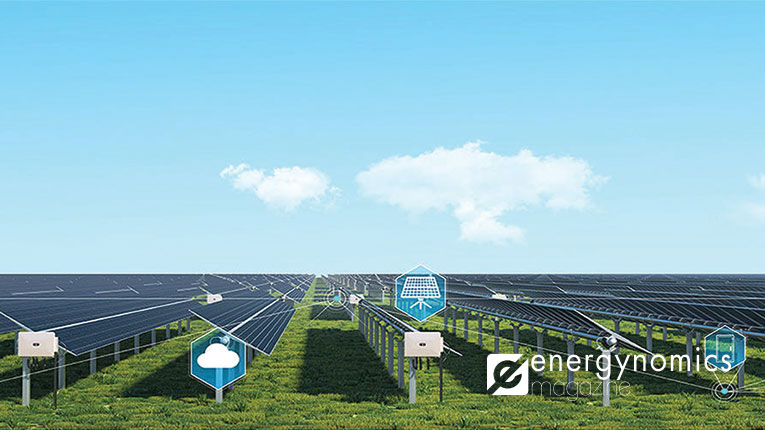Carbon neutrality is a shared global mission. It’s not a slogan. It’s an action. It’s the technologies, products, solutions, and services such as PV inverters and storage solutions, many people are working hard for. Individually, these products may not solve such a big challenge as climate change. Added up, however, the numbers could be way more staggering than we think. The International Energy Agency (IEA) estimated that renewable electricity generation would grow by 8% in 2021. Solar PV and wind are now slated to contribute two-thirds of the growth in renewables. Meanwhile, engineers at Huawei are also actively working toward a greener world. Frankly, all of our future depends on achieving carbon neutrality, which is a daunting thought. It’s difficult to know where to begin. At Huawei, we start with the tech.
Carbon neutrality
Low carbon, electrification, and intelligence are the key to carbon neutrality, which relies on advances in science and technology to reduce energy consumption and carbon emissions, gradually decoupling economic growth from carbon emissions.
Globally, we are seeing three key trends. The first is the fourth industrial revolution, which is making our world smarter. The second we’ve already discussed, carbon neutrality is driving an energy transformation towards a clean, low-carbon, safe, and efficient energy system. And finally, we are seeing technology play an increasingly important role in clean energy.
Specifically, the third trend is the convergence of energy and information flows which will enable renewable energy to serve as the primary energy source in new power systems. Traditional power systems with limited digital automation and interactions will eventually be replaced by more efficient, digitalized, and intelligent alternatives capable of sensing and interacting.
Meeting demand
The levelized cost of energy (LCOE) of global renewable energy, such as PV and wind power, has decreased rapidly since 2018. It is now significantly lower than the cost range of fossil energy. This is the first step in renewable energy becoming the primary energy source. Renewable energy could meet 86% of global power demand by 2050, IRENA concludes. We will also see installed PV capacity increase from one Terawatt today to 8,5 TW, in 2050.
In terms of energy consumption, electric energy from cleaner energy mixes will gradually replace traditional fossil fuels. The usage of electricity will surpass oil by 2050, growing from 20% in 2017 to 49%. Manufacturing, construction, and transport are major industries that need to switch to electricity to go green. In addition, green buildings and campuses will be built using renewable energy, improving their energy efficiency.
While the increasing penetration rate of renewable energy and electric vehicles is positive for carbon neutrality, it also represents a huge challenge for the stability of conventional power grids as they need to shift from centralized to distributed power generation. To maintain their stability and reliability, intelligent collaboration and scheduling technologies must streamline power sources, grids, loads, and storage devices for peak shaving. This will improve energy efficiency and grid stability, while reducing energy costs. Huawei will be an active player in the journey toward carbon neutrality. Through technological innovation, Huawei will help industries reduce energy consumption, accelerate the transformation of their energy mix, and make clean, stable, and affordable energy accessible to every business.
New system
Huawei’s Institute of Strategic Research forecasts that renewable energy will account for more than half of all energy produced in 2030, half of all vehicles sold will be electric, and electric transport will become the norm. Within this context and in the next decade, ICTs have the potential to help industries reduce carbon emissions by 20%.
To position renewable energy as the primary energy, new power systems will integrate digital and physical systems to optimize energy and service flows using data. Data will be a core production element for streamlining power sources, power grids, loads, and energy storage. It will make power generation visible, measurable, and controllable. Power grids will be controlled by a coordinated cloud and edge system, and power consumption will be supported dynamically by pooling a massive number of resources.
In the digital industry, Huawei will pursue four “green” directions, focusing on innovation and open cooperation.
Four green directions
Integration: We will continue to integrate leading power electronics technologies with digital technologies, converging energy and information flows to manage watts with bits. This will promote the digital transformation of the energy industry.
Clean power system: We will develop a clean power system using primarily renewable energy sources. This synergy of power sources, grids, loads, and energy storage will help renewable energy replace fossil fuels.
Electric vehicles: Electric transport users are still concerned with charging convenience, mileage, and safety. To ensure a good user experience, Huawei will build a converged, simplified, safe, reliable, and intelligent electric power solution. We will also develop charging and swapping network solutions that integrate PV power generation and storage to interact with users, vehicles, charging stations, roads, and networks.
Green data centers: ICTs are consuming more and more energy. By 2025, data centers and telecom sites will consume 950 and 660 billion kWh (3% and 2% of global electricity consumption) per year, respectively. Huawei will build zero-carbon, efficient, and intelligent green ICT infrastructure solutions for data centers and telecom sites.
Global partners
Huawei digital power integrates power electronics technologies with IoT, big data, and AI to minimize power generation costs, maximize bits transmitted per watt consumed, support the increasing computing power of data centers, and enable green transport for everyone. United, we can achieve anything. Peak carbon emissions and neutrality goals require the collective efforts of every player in the industry. Huawei will continue to promote its open cooperation strategy and work with partners throughout the industry to save our planet.
_____________________________________________
This article first appeared in the printed edition of Energynomics Magazine, issued in December 2022.
In order to receive the printed or electronic issue of Energynomics Magazine, we encourage you to write us at office [at] energynomics.ro to include you in our distribution list. All previous editions are available HERE.
